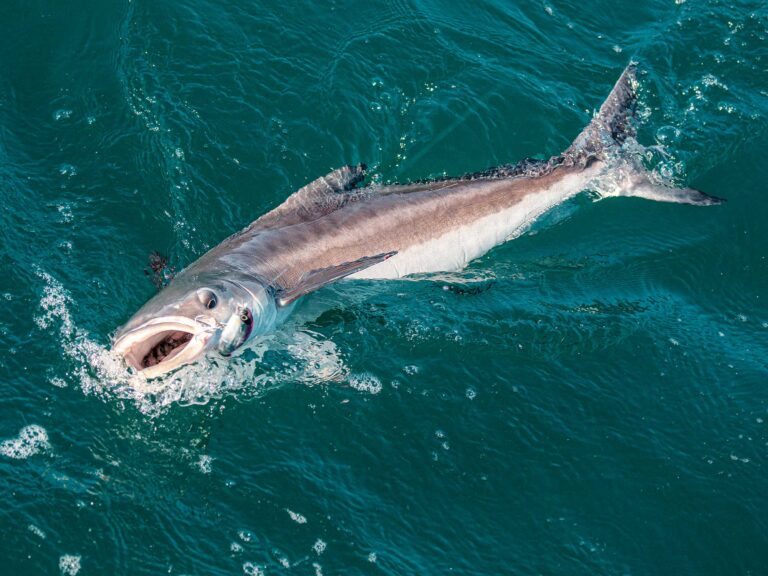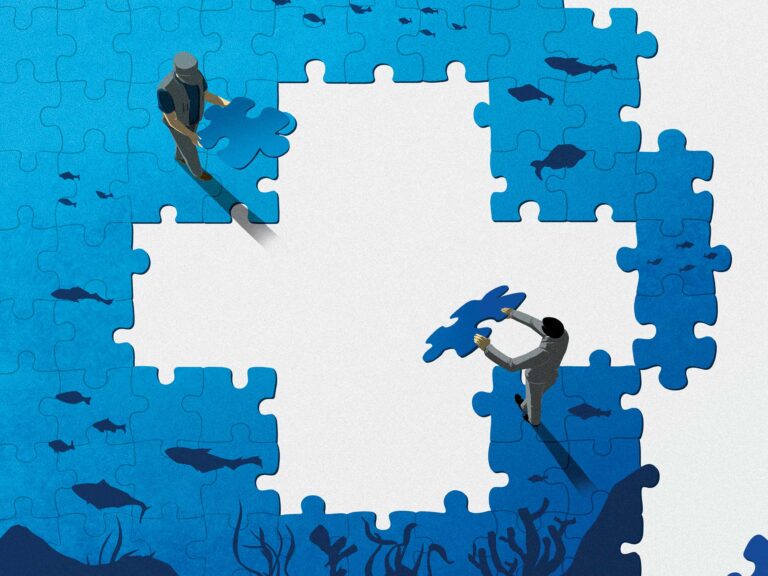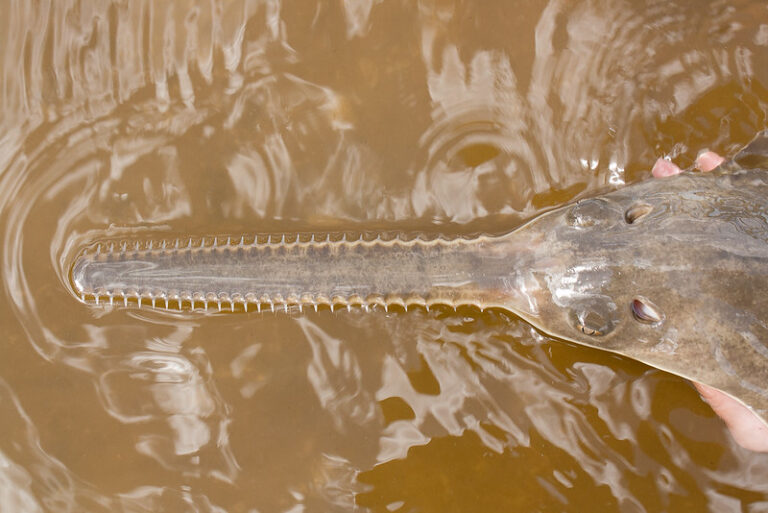The Great Barrier Reef, not the blue whale, is the largest living thing on the planet. The world’s most extensive assemblage of coral reef, the GBR is actually 3,400 interconnected reefs stretching 1,200 miles north-to-south off Australia’s northeastern coast, covering an area roughly the size of California. And is it ever alive. Over 400 species of living coral provide food and sanctuary for 1,500 species of fish, along with numerous whales, dolphins and sea turtles.
The Great Barrier Reef attracts humans, too. It’s a tourist mecca, drawing millions of visitors from around the globe to enjoy unparalleled underwater scenery and some of the best fishing anywhere. A multi-billion-dollar sport fishing industry thrives on the chance to hunt giant trevally, red emperor (snapper), black marlin, yellowfin tuna, Spanish mackerel, coral trout and myriad other species.
Trouble on the Reef
But the Great Barrier Reef ecosystem is in big trouble, according to scientists who monitor the quantity and quality of life there. The threat comes from human activities at sea and on land. A major battle is brewing over competing uses and claims on the best way to save it.
In June, the GBR Marine Park Authority announced a controversial plan to re-zone the 131,000-square-mile area of ocean. A key part of this plan is an expanded network of “green zones” that would give full protection to a large chunk of the park. Not surprisingly, the park authority’s plan has provoked a “historic” response, including over 10,000 public comments. The stakes are high and the stakeholders are many and formidable: National and international environmental groups, Australia’s 1.2 million sport fishermen and supporting industries, the region’s agricultural interests, even organized crime.
The government’s re-zoning proposal would turn about 30 percent of the reef into green zones; that is, areas with no recreational or commercial fishing allowed. It’s expected to be approved later this year and, if it is, would take effect in 2004. Not satisfied, some political leaders and environmental groups are pushing to set aside at least 50 percent. Currently less than five percent of the Marine Park is fully protected. (This number is deceiving, however. According to the independent World Conservation Monitoring Centre, which works under the auspices of the United Nations Environment Programme: “Whilst the area (currently) designated free of tourism or fishing may seem low, it must be recognized that the Marine Park encompasses large areas of open water, so that the proportion of reef so designated is, in practical terms, much higher.”)
Overfishing is a genuine concern, although sport fishing is rarely cited among the culprits. Bottom trawling is the most destructive form of fishing allowed in the GBR. Trawling for prawns, or shrimp, “destroys ten times more creatures than are actually harvested,” notes the World Wildlife Fund, a strong proponent of the zoning proposal. Most trawling takes place in the reef’s shoreside lagoons, which are rich in seabed life. “Huge areas of seafloor are laid to waste by destructive trawl gear,” the group says.
Poaching Problems
Another major threat to the reef’s fisheries comes from poaching. Illegal fishing within existing sanctuaries, primarily for coral trout, is on the rise and taking a toll on the stocks. Coral trout are one of the most sought-after reef fishes in the tropics because they are such fine eating. Because they inhabit the most accessible reefs near shore, they can be fished out easily if unprotected.
Anglers fish under size and bag limits, and must bring all fish whole to the dock. It’s the fish brought in alive, however, that are of most concern. Live coral trout, sold to markets in China, can bring local fishermen anywhere from $50 to $100 (U.S.) a pound. Police sources in Australia say the Asian crime syndicate has infiltrated the lucrative fishery. The ability of the marine patrol to enforce catch limits throughout the sprawling Marine Park and monitor fishing in prohibited areas is severely challenged.
But far and away the most serious danger to the reef comes from the mainland. It flows down the rivers and into the estuaries that each spring provide the delicate blend of fresh and salt water so vital to the diversity of life in the coastal region. Into this mix flows polluted runoff from farms and sediments loosed by clearing land for cattle grazing. Pesticides, fertilizers and other harmful residues are smothering the reef, warns a recent report by the government’s Productivity Commission, retarding the growth of coral while producing excessive concentrations of phytoplankton. The excess nutrients fuel the spread of other organisms that compete with or replace the coral.
The State of Queensland’s sugar cane farms have been singled out as a primary contributor to coastal pollution. Dismissing these concerns, the sugar industry has responded by pointing fingers at other causes, such as urban runoff and tourism (waste discharge from boats, anchoring practices, reef walking, collecting, etc.).
No More Fishing?
With so many threats to the Great Barrier Reef coming from so many sources, why are no-fishing zones emerging as the most visible, and volatile, issue in the debate over how to save it? As most anglers know by now, there is a growing tidal wave of support for using marine reserves as the primary means of preserving biodiversity. Reserves, the most restrictive form of Marine Protected Areas (MPA), can be an effective conservation tool, relieving pressure on fish stocks where they concentrate and are most vulnerable to fishing. Because coral reefs are discrete areas with resident populations of fish, putting them off-limits to harmful fishing practices can work wonders.
But the Marine Park authority and its environmental supporters are proposing to keep sport fishermen out of all the new green zones, too, including anglers who troll through the area for migratory pelagic species such as billfish and tuna. Anglers who fish in the water column above the reefs feel they are being unfairly painted as bad guys by a broad-brush approach to MPAs, treated no differently than the trawlers and scofflaws.
Anglers’ fears of being haphazardly shut out of prime fishing grounds are widespread in Australia, just as they are here at home. They worry that closing off large areas of the Great Barrier Reef could be a tropical punch in the gut to the region’s fishing industry. It’s not that they want to be exempt from conservation measures. From what I’ve seen, most of them are willing to take a hit if that’s what it takes. They just don’t want to get hit by a shotgun blast aimed at someone else.
Aussie anglers do see the value of MPAs. Ten newly created sanctuaries for the grey nurse shark, for instance, where certain types of bottom fishing will be prohibited, have won their support. The sanctuaries make sense to them, designed as they are to achieve a specific conservation goal. While recreational fishing and diving activities considered to impact the endangered sharks are banned, trolling and fly fishing for pelagics, deemed benign, will continue. Some environmental groups are unhappy, however, as they want all fishing excluded from the new sanctuaries.
An all-or-nothing approach to reserves is neither necessary nor practical, and only enhances the odds that we will all get nothing. There are and will be sensitive areas, in the GBR and elsewhere, that demand total protection from all forms of fishing. On the other hand, limited closures – closed seasons, areas where only destructive fishing gear is eliminated – are broadly supported by fishermen and already in wide use. These kinds of MPAs hold great promise for enhancing Australia’s or any other country’s marine resources and dependent fisheries. But if the issue is mishandled, as has been the case in the U.S. so far, wherein all fishing is treated as if it were bad, it will only breed mistrust among conservation-minded fishermen and turn potential allies into adversaries.
“Green zones will not protect any other part of the biodiversity of the ecosystem other than that which is removed or destroyed by extractive methods,” says Laurie Wright, president of the Cairns Professional Game Fishing Association, which represents anglers who troll the reef for pelagic species such as marlin and tuna. “It is not addressing pollution problems, soil runoff or loss of habitat. There are much better management tools available than to deny access to a group of users that have proven beyond doubt that they do no damage to the biodiversity of the area.”
MPAs Won’t Solve Problem
Expanding the number of no-fishing zones will look good on paper, sound good to the general public and make some people feel good. But there’s a chance it could leave the real problems unresolved. The major threats to the GBR, according to virtually every reliable source, including the government, are pollution and coastal development, commercial trawling, and poaching. Each of these by itself will be difficult enough to overcome. Together they are daunting. At the very least, it’s poor strategy to needlessly alienate fishermen whose political clout will be essential to solving these larger problems.
I believe anglers should, and ultimately will, embrace the use of MPAs as a management tool, even when it means they, too, will have to give up fishing. But at this stage of the debate, that tool is too often wielded like an indiscriminate weapon. As Dr. Robert Steneck of the University of Maine’s School of Marine Sciences warns, we “don’t want a situation where all (we) have is a hammer so everything looks like nails.”
Instead, what we need is a judicious, common-sense approach to the use of reserves. We’re not there yet, but we’re moving in that direction. Leaders from the U.S. marine recreational fishing industry met in St. Petersburg, Florida, in February, prompted in part by the need for a collective response to the MPA issue. The mission statement the group produced is worth reprinting here: “In the spirit of conservation, create clearer definitions and specific science-based guidelines for the establishment and management of marine protected areas, including public involvement, conservation goals, provisions for enforcement, and evaluation criteria.”
Too simple to be helpful, you say? Maybe, except for two things. This doesn’t sound like a battle cry to me, rather something offered in the spirit of compromise. It’s a process that nearly all groups, on all sides of the issue, say they support, but are rarely willing to follow. So it’s a start – something on which to build a dialogue in search of common ground.
Compromise demands give and take, nowhere more than on this contentious issue. Anglers must make it clear to environmentalists that they are willing to give up what they must in order to help the fish and make fishing better. Environmentalists must make it clear to anglers that better fishing is one of their objectives, and that their take on MPAs includes promoting selective and sustainable methods of fishing where they do no harm. That way we can all be the good guys and work together.









